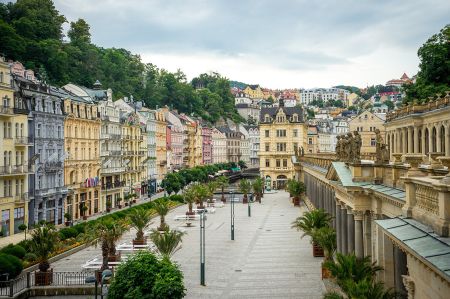Karlovy Vary thermal springs - historical development
- Written by Portal Editor
The healing properties of Karlovy Vary's thermal springs were well known as early as the 14th century. There is a legend about the discovery of the warm springs, according to which a thirsty deer is said to have uncovered the first warm spring with his hooves.
The so-called Deer's Leap (Jelení skok) above the valley of the Teplá with the main promenade also reminds of this.
First used for baths, then for drinking cures
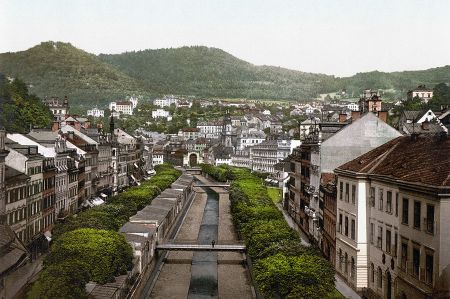 On August 14, 1370, the Czech king and Holy Roman Emperor Charles IV granted the city of Karlovy Vary the same freedoms and rights that the neighbouring city of Elbogen had. The springs were initially used for baths, and from the 16th century also for drinking cures. In 1522 the first written treatise on the healing power of the springs appeared.
On August 14, 1370, the Czech king and Holy Roman Emperor Charles IV granted the city of Karlovy Vary the same freedoms and rights that the neighbouring city of Elbogen had. The springs were initially used for baths, and from the 16th century also for drinking cures. In 1522 the first written treatise on the healing power of the springs appeared.
On May 9, 1582, the city was inundated by a strong flood and on August 13, 1604 it was almost completely destroyed by fire. The Thirty Years' War also left its mark. Karlovy Vary recovered only slowly. In 1707, however, Emperor Joseph I confirmed all the privileges as a free royal city. The spa business was promoted primarily in 1711 and 1712 by the visits of the Russian Tsar Peter the Great. In 1711 the city's first spa was built. In 1759 another fire destroyed a large part of Karlovy Vary. The use for cures was then decisively promoted by the doctor David Becher. He had published a paper on spa treatment in Karlovy Vary and encouraged the promotion of Karlovy Vary sparkling salt. In 1795 a spa fee was introduced, with the help of which the town was to be rebuilt.
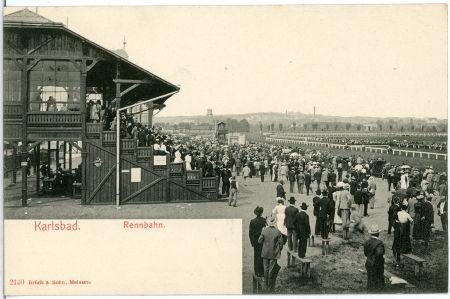 In 1819 the Karlsbad conference took place in the city, at which the Austrian chancellor, Prince Metternich, in the Karlsbad resolutions, stipulated that all states of the German Confederation be subject to strict press censorship and other measures against the democratic efforts that had existed since the wars of liberation.
In 1819 the Karlsbad conference took place in the city, at which the Austrian chancellor, Prince Metternich, in the Karlsbad resolutions, stipulated that all states of the German Confederation be subject to strict press censorship and other measures against the democratic efforts that had existed since the wars of liberation.
In the middle of the 19th century, bathing experienced a significant boom. With his publications on the Bohemian spas and the effects of their medicinal waters, the balneologist and imperial personal physician Josef von Loeschner helped Karlsbad to flourish as a world-renowned health resort. The decisive factor was the connection to the European railway network in 1870. First, operations were started on the Karlsbad–Eger line, followed shortly afterwards by the Prague–Karlsbad line.
On November 24, 1890, the city was again hit by a flood.
Loan of 500 marks from the city of Karlsbad on October 1, 1892
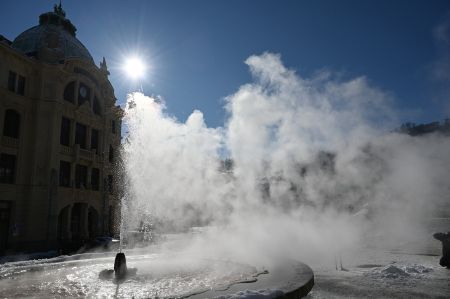 In Meyers Konversationslexikon from 1898 one can read about the cure in Karlsbad: “One drinks 3-6 cups in the morning and uses both mineral water and steam baths as well as mud baths with great success, for which the mud is taken from the Franzensbader Moorlager. The spring products from Karlovy Vary are also important, namely the sparkling salt, which is obtained by evaporating the spring from the spring. The annual dispatch of Carlsbad mineral water was over 1 million bottles and jugs, of sparkling salt and sparkling soap over 23,000 kg.” In 1756, 134 families came in the spa season and at the end of the 19th century there were an average of 26,000 spa guests, this number rose to almost 1911 71,000.
In Meyers Konversationslexikon from 1898 one can read about the cure in Karlsbad: “One drinks 3-6 cups in the morning and uses both mineral water and steam baths as well as mud baths with great success, for which the mud is taken from the Franzensbader Moorlager. The spring products from Karlovy Vary are also important, namely the sparkling salt, which is obtained by evaporating the spring from the spring. The annual dispatch of Carlsbad mineral water was over 1 million bottles and jugs, of sparkling salt and sparkling soap over 23,000 kg.” In 1756, 134 families came in the spa season and at the end of the 19th century there were an average of 26,000 spa guests, this number rose to almost 1911 71,000.
The town has well-preserved historical spa facilities, including the White Colonnade, Market Colonnade (1883 by Fellner and Helmer), Mill Colonnade (1871–1881 by Josef Zítek), Park Colonnade (Garden Colonnade), Spring Colonnade (1969–1975 by Prof. Votruba) and the palace colonnade (1911–1913 by Friedrich Ohmann). In all of the colonnades mentioned there are healing wells (pramen), the temperature of which is sometimes over 60° Celsius.
Snake Spring in the Park Colonnade
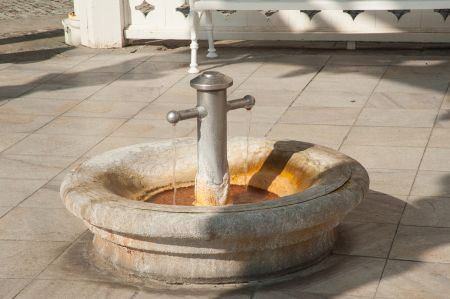 Karlovy Vary has twelve springs, at the beginning of the 20th century 18 alkaline-saline mineral springs were reported. The most famous and strongest spring is in the White Colonnades and is called Vřídlo. It has a temperature of 72 °C, shoots up to 14 meters in the air and pours 2000 litres per minute.
Karlovy Vary has twelve springs, at the beginning of the 20th century 18 alkaline-saline mineral springs were reported. The most famous and strongest spring is in the White Colonnades and is called Vřídlo. It has a temperature of 72 °C, shoots up to 14 meters in the air and pours 2000 litres per minute.
A total of 89 outflows of mineralized thermal water have been documented in the central spa area, 19 of which are natural medicinal waters approved under the Spa Act. It is hypotonic, strongly mineralized spring water of the Na-HCO3SO4Cl type (alkaline, contains Glauber's salt).
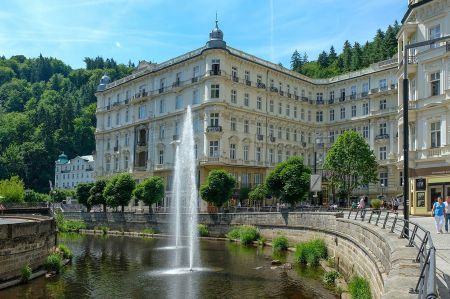 The applications of Karlovy Vary's healing springs are diverse: disorders of the digestive system, metabolic disorders, diabetes mellitus, gout, obesity, periodontal disease, diseases of the musculoskeletal system, liver, bile, bile duct and pancreas diseases as well as oncological diseases. The laxative effect of the medicinal water is due to the Glauber's salt. This effect on the human organism is desirable, so sensitive people such as children and pregnant women should only drink the healing water to a limited extent.
The applications of Karlovy Vary's healing springs are diverse: disorders of the digestive system, metabolic disorders, diabetes mellitus, gout, obesity, periodontal disease, diseases of the musculoskeletal system, liver, bile, bile duct and pancreas diseases as well as oncological diseases. The laxative effect of the medicinal water is due to the Glauber's salt. This effect on the human organism is desirable, so sensitive people such as children and pregnant women should only drink the healing water to a limited extent.
Please read as well:
